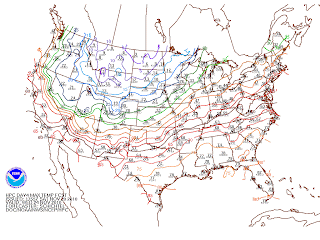Considering that I am "THE weather woman" at the local Starbucks, there is quite a high expectation when it comes to knowing everything about the weather including details on the daily forecast. Today my friends, I am admitting to falling short on being knowledgeable about the cool weather the North East has experienced today (Monday). My only excuse is that for the past week despite the lovely curve ball life has thrown me, my head has been too far up my you know what, to even muster the energy to study and discuss the current weather. One of my lovely customers this morning came into the store looking for me to tell me all about the weather that we were having and wanted to know why, when he unfortunately found out that one, I was not in for my shift yet, and two, I didn't know what was going on besides it being a bit breezy this morning.
Now that I have done my research, let us talk weather!
So, what happened today in the North East, was a pretty rare event. Something to be quite excited about. After realizing what was going on, I wished I had known about this yesterday!
As of this morning, there was a deepening low pressure system off the Cape Cod coast and was moving Southwest! Storms typically do not move in the Southwestward direction. This storm was like a reverse Nor'easter... very cool. Nor'easters are systems that generally form off the East coast and move North and East. This storm was back tracking a Nor'easter. Considering how dry the air was in central Jersey that is, the dynamics from this particular storm did not hold has much 'umpf' as a typical Nor'easter.
For portions of New York, New Jersey, and Pennsylvania, a Wind Advisory was posted for the potential for winds of 20-30 mph, higher winds near the coast, throughout the day. The
gradient (the rate of change with respect to distance of a variable quantity, as temperature or pressure, in direction of max. change. NWS.) was forecasted to tighten; meaning there was a strengthening in the system and potential for high winds, as the system
deepened (decrease in central pressure of a surface low systems; an intensifying storm) on its Southwest trek.
Towards the afternoon, when the low reached it intensity, the wind advisory that had been earlier posted was canceled as upper air sounding became less
adiabatic (changes in temperature caused by the expansion; cooling, or compression, warming, of an area of air as it rises or descends in the atmosphere, with no exchange of heat with the surrounding air (NWS)). As the low began to retrograde (the movement in the opposite direction) at its peek and slowly began to stabilize, as drier air crept its way wrapping around the system. The dry air was was kept the bulk of the precipitation from falling. Otherwise, categorical precipitation could have fallen. Some areas, mostly in the higher elevations, but was also observed locally, experienced sleet. The drier air that was over our air
evaporated (evaporation is a cooling process) cooled our air mass which made it possible for sleet to fall.
Now, '
sleet' is along with other types of precipitation is a pretty neat phenomena. I will save that lesson for another time.
Sleet is defined as pellets of ice composed of frozen raindrops or refrozen partially melted snowflakes. Do not be confused with hail, because sleet in typically smaller than hail; usually hurts and stings a lot more when hit by it, unless of course you're hit by a baseball size hail ball that was falling at 75 mph plus!
 |
| Depiction of Sleet Formation. Courtesy of NWS |
The higher elevations had sleet and snow flurries along with portions of Massachusetts and Connecticut. Tis' the time for snow to fall! Scattered showers and rain fell in central New Jersey. I might add, it was quite cool to see today a cutoff line in the sky to the West in Pennsylvania where you could see a separation between our gloomy skies rain skies and the sun and clouds.
 |
| Red arrows show counterclockwise wise circulation, white arrow shows system track .Courtesy of NOAA/NWS |
 |
| NOAA GOES East Infrared Image. Courtesy of NOAA |
High pressure is forecasted to move in Wednesday setting up shop for most of the week. With the exception of early Wednesday with few clouds, mostly sunny skies is what the hi-light is going to be. Temperatures will get back to seasonal ranging in the 50s, falling to middle to upper 30s towards the evenings.
~V.S.











.png)





